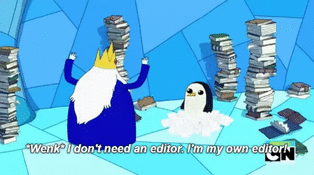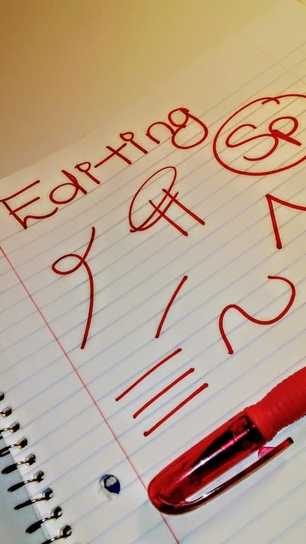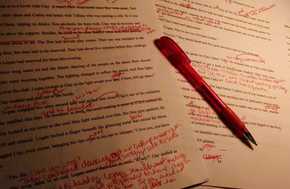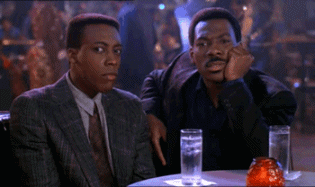Before you can get to editing, you have to get your first draft out. I call this the vomit draft. Why? Because when I’m writing a first draft, I don’t stop to do paragraphs or even punctuate. I leave sentences half-finished if I can’t immediately decide what I want to say because I don’t want to break my flow. And I definitely don’t stop to look anything up. If I’m unsure of a fact or need a character name, I just type XX as a place holder. (I learned this tip from another writer, but I can’t remember who. Thank you, smart writer!) It’s easy to find with Word search features because there are few (maybe none?) words that have XX in them, which means you won’t get a lot of unnecessary results. When I’m finished vomiting on to the page (yuck!) I take a break and get away from it for a while. **Side Note! Should you edit while writing? I don’t recommend it. Writing and editing are two different brain processes. And if you stop your writing to edit, it will take you forever to actually get the completed story out because you keep nitpicking over little bits. Let your brain tell the story. Then go back and whip it into shape.
Once I’m finished with a few rounds of self-editing, I have the For Your Eyes Only draft. At this point, I’m ready to send it off to someone else to read. That can be one of two persons, a beta reader and/or an editor. I’ll break and explain what each one is and does. Beta Readers. They are precious cinnamon rolls of perfection. These are people who already read your genre that you can give your manuscript to for reader feedback. Why is it important for them to be fans of your chosen genre? Because they have an innate ability to know what to look for as far as what they’ve already seen and enjoyed or hated in similar books. With that knowledge, they can tell you if you’re in the ball park or way off in a park of your own. Their job is to tell you things like did I enjoy this book? Are the characters likeable? Were there any parts I didn’t like? Their job is not to edit your work as far as grammar, sentence structure, spelling, time line, etc. Editors. These are the folks with the red pens. It is their job to find grammar mistakes and work with you on sentence structure. They address plot holes, eliminate passive voice, point out time line mistakes, etc. It is not their job to fix or re-write your book, which is why you don’t give them a first draft. The editor only receives a book after you’ve made it the best you can make it. They can turn silk into a purse, but they can’t do the same with that pig’s ear of a first draft, you know what I’m saying? I’m going to detour for a moment here to address a debate that I see often and have been a part of. The Do I need an editor? debate. (This is for self-published authors. If you’re with a publishing house, you will be assigned an editor.) In my opinion: yes, you do. You shouldn’t take a story that only your own beautiful eyes have looked at and send it out into the ether. Just like people can’t see if they have an ugly baby (even though all babies are beautiful!) you can’t see if your book baby is ugly. But. If you’re self-publishing, it can be difficult to find an editor. Or, maybe hiring an editor isn’t financially feasible for you. If that's the case, there are other options.  Don't be this cartoon guy. Don't be this cartoon guy. Remember those super-duper lovely beta readers? Some of them actually do edit. You can also work with people like English teachers or majors, or even try a swap with another author. Will your results be as good as working with an actual trained editor? Nine times out of ten, the answer there will be no. It’s a risk you take. But again, the point is other eyes besides your own (and your loving mother’s) must take a look at your story. Finally, the day will come when you get the email that your beta and/or editor has sent with your document corrections and suggestions. After taking a day to work up the nerve to open that email, you start reading through the edits. Do you have to take all of the suggestions? No. But this is where it’s important not to get Writer’s Big Head. Your first reaction to suggestions may be, “What do you mean you don’t like that I gave the hero purple arms? That’s who he is as a purple armed man!” It can be hard to change something that you birthed in your brain. But take a second and think about it. If multiple readers don’t like, or are squicked by something in your story, that may be an indicator that it needs to be changed. If your editor tells you that you spent too much time getting from plot point A to plot point Z, or worse, got to point Z with very little explanation how, that might be something you need to address. The betas and editors are there to enhance your story, not tear it apart or make it their own. (If you get a meany-faced beta/editor who does want to rip up your story, run away) Alright, you’ve made the suggested changes so that means your book is ready to go. Haha! J/k. Now it needs to be proofread. This is where someone goes over the manuscript with laser eyes to look for incorrect names/words, missing punctuation and other tiny errors.
Having someone else do the proofreading is the best option. But if that isn’t an option for you, here’s a little trick. Change up the format you’re reading the document in. If you’ve been working in 12 pt Times New Roman Black, change the font to 16 pt Courier Purple. Even better, save it and read it as a PDF. Even triple better, make an e-book version of it (you can do this in Calibre) and read it that way. The change in the way the WIP is formatted will help you slow down and catch errors, rather than speeding over the words because your eye is so used to the way they look. Okay, now you’re ready to upload that manuscript for sale. Whew, that was a lot of work! And crazy enough, even after all that you still might have an error or two. That’s okay. We’re not book writing robots and readers are generally kind enough to understand that we aren’t. Thank you, readers! So, that’s editing! Friendly reminder that I’m not an expert and I’m just sharing the knowledge I’ve gained so far. If you’d like more knowledge, check out Grammar Girl’s Quick and Dirty Tips for Better Writing and Write and Revise for Publication. And if you have any questions, feel free to let me know in the comments. Thanks for reading! Christa www.ChristaTomlinson.com Follow me around the internet! Facebook, Twitter, Instagram, Goodreads View my titles on Amazon
1 Comment
5/4/2017 01:44:56 am
This novel is the really great and second year student are reading the complete novel of the Mr. Chips and this novel is the also so good. Different novels books are available in the market and people is reading the novel before the sleeping.
Reply
Leave a Reply. |
Christa's Blog
My rambling and not at all edited thoughts on romance novels, writing, and pop culture. Tags
All
|





 RSS Feed
RSS Feed
